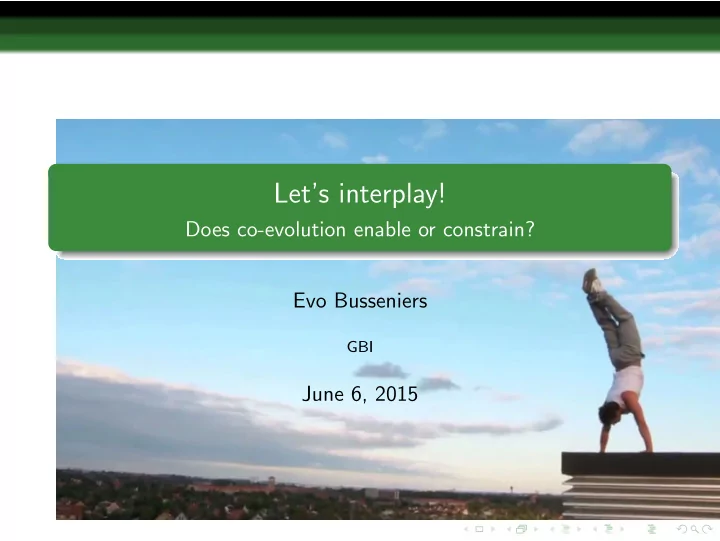

Let’s interplay! Does co-evolution enable or constrain? Evo Busseniers GBI June 6, 2015
Table of contents Introduction 1 Co-evolution 2 Chemical organization theory 3 Power in cybernetics 4 Conclusion: lessons for the Global Brain 5
Introduction Interplay
Introduction Perils Agents form structure, but this structure dictates agents not necessary wanted: addiction/ supernormal stimuli; state Technology Democracy
Introduction Alternative build our world constant evolution diverse, contradictory constant opposition
Co-evolution Classical evolution vs co-evolution classical: fixed fitness landscape: f ( x ) co-evolution: fitness landscape changes as you move along it: f ¯ x ( x ), with ¯ x from previous x’s, or x’s from other agents
Co-evolution Classical evolution vs co-evolution: example f 0 (0) = 0; f 0 (1) = 1 f 1 (0) = 1; f 1 (1) = 0
Co-evolution Socio-technological agents A i with fitness f ( x i ) positive feedback: f ( x i ) higher → more influence on f : ← f ( x i ) + k · f ( x i ) f ( x i ) k f ( x j ) ← f ( x j ) − n − 1 · f ( x i ) ∀ j � = i
Co-evolution Opposition General positive feedback model Opposition: don’t take from all, but from the one with biggest fitness f ( x j ) ← f ( x j ) − k · f ( x i ) for j : f ( x j ) max
Co-evolution Link with second law of thermodynamics
Co-evolution Result Classical: With resistance: Median=4 . 0924 e − 067 Median=0 . 8646
Chemical organization theory Principles Method= reaction(s) Goal(s)= Organization/ products of reactions Method emerges in certain environment, to reach goal. This environment evolves
Chemical organization theory Agent model Agent has goal set G i = G rival + G unrival : G rival + G unrival → G unrival + S i Agent choose method(s) (reactions) to reach goal (is catalyst) Organisation (hopefully) emerges Mutation → are the goals still reached?
Chemical organization theory From exploiter to cultivator exploiter: monopolizes resources, predator (A → 0) (evolves to) cultivator: builds organisation that overproduces A, so it can take it (A → 0) not necessary ”good” for agents in it
Chemical organization theory From exploiter to cultivator: example Worker + Time W → Worker + Good Good → Money Capitalist + Money → Capitalist + Money C exploiter → cultivator by adding Time + ǫ Money → Time W + ǫ Money W while there is a constant input of time: ∅ cst → Time
Power in cybernetics A definition Power: ability to act: how much result you got from a different action Power of A 1 = d ∆ 1 da 12
Power in cybernetics Power vs influence: examples
Power in cybernetics Power vs influence: examples
Power in cybernetics Power vs influence: examples
Power in cybernetics ( , . . . v n ) v 1 , . . . , v i v j , . . . , v k v l , . . . , v m , , � �� � � �� � � �� � Independent goal space A Independent goal space E Intersecting goal space A and E Several preferred states + variables depend on each other Power, ”Imposing structure”= No act of A can put it out of attractor → no influence on it (but matters) Can’t really look to goal A independent of goal E, because connected (nature/nurture problem)
Conclusion: lessons for the Global Brain Democracy Division of decision and acting Necessity to make a (global) decision?
Conclusion: lessons for the Global Brain Example: neighbourhood formation
Conclusion: lessons for the Global Brain Example: Peer review
Conclusion: lessons for the Global Brain Libertarian paternalism
Conclusion: lessons for the Global Brain Libertarian paternalism
Conclusion: lessons for the Global Brain Libertarian paternalism
Conclusion: lessons for the Global Brain Libertarian paternalism
Conclusion: lessons for the Global Brain Lessons for the Global Brain Imposing structure (by technology), impossible to resist since omnipotent and omnipresent? Or constantly evolving structure that enables us to build the world we want? alienate our decisions from our acts? The choice is ours, constant opposition
Conclusion: lessons for the Global Brain Thanks for listening!
Recommend
More recommend